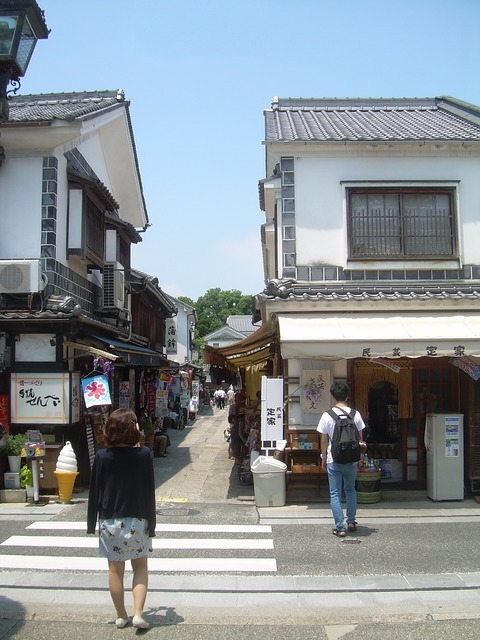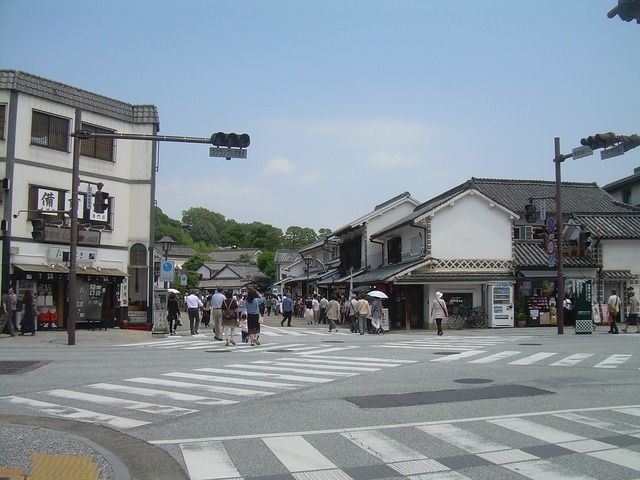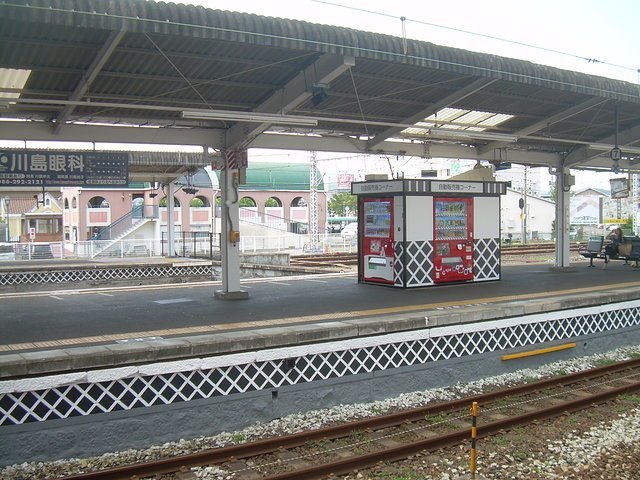Kurashiki (Okayama Prefecture)
| Travel Reports by FancyLampshade | view profile of FancyLampshade |
| previous post |
| next post |
| Note: The opinions and views expressed in this user report are those of the individual author and do not necessarily reflect the opinions and views of japan-guide.com. |
June 26, 2016 - Kurashiki (Okayama Prefecture)
Since there were no curtains in my room I woke up together with the sun and decided to walk around before I had to leave.
There isnft anything worth of sightseeing in the small town of Asakuchi where I stayed the night, but there is a shrine (Omiya Jinja) nearby, so I went to check it out and, funny thing, I found an old kura storehouse just like the ones Ifd be seeing in a few hours in Kurashiki, only much smaller. Having the place to myself, I wasnft embarrassed to stop and stare at it closely, so I was able to have a good look at the architecture.

Back at my hostel, I donft know how I managed to fall asleep again after packing my bag and having a shower, but when I woke up it was already half past eight so I quickly got up and hurried to the station, leaving a note behind saying I had enjoyed my stay very much. I like to be at the different sites at opening time to make the most of the day, but I arrived a little late to Kurashiki.

For those of you wondering what there is to do in Kurashiki, the city has a neighbourhood by the name of Bikan preserved as it was in the Edo Period. The buildings in Kurashiki are traditional Japanese storehouses known as ekuraf, hence the name of the city. Kura were used to store only precious items, like rice or sutras later on, and started appearing as early as the Yayoi Period.

There are many types of kura storehouses such as eazekuraf (log cabin), board-wall kura (you can see some at Shirakawa-go), eishiguraf made out of stonec but the ones we find in Kurashiki are known as eearthen kuraf. These types of constructions usually have a wooden structural frame with the walls being covered in clay and coated with plaster in order to make them fireproof. In Kurashiki we can see two different styles of tiling: laid diagonally and fixed with white plaster to keep them in place --this style of tiling is called enamakof (literally esea cucumberf because of the rounded plaster)-- and horizontal tiles. I think the tiling is to protect the walls from damage since the clay isnft too strong.

Today, many of these old storehouses have been turned into museums and shops. In all honesty I wasnft sure if Ifd like Kurashiki too much since it seemed to be a more touristy area but, although it was touristy, many of the people there preferred to do some shopping while I was completely alone in the museums I went to. I enjoyed Kurashiki very much.

Reaching the Bikan area I first stopped at the information centre to buy a ticket for a boat ride (500yen) down the canal passing through the middle of town. I had arranged the dates so that I would be in Kurashiki on a weekend since they only offer boat tours on Saturdays and Sundays, and I had my fingers crossed it wouldnft rain today.

They gave me hour for 10:30 and since it was just past 9am, I had time to visit one museum first. The Toy Museum was my favourite, with displays of toys from all over Japan ranging from figures portraying legendary characters such as Kintaro, Momotaro, and the one and only Urashima Tarou (to state the most popular), but also full tables of kokeshis, darumas, kites and --I had to look up this word on translator, so Ifm not sure if it is correct-- spinning tops. The owner of the place has the world record for spinning a spinning top for the longest time, and he had his certificate displayed for all to see.


I left the museum running once I saw what time it was, and the boatman was delighted to see a foreigner in Kurashiki. I think the boat was what made my day, nobody there spoke English and the twenty minute tour down the canal was entirely in Japanese but the guide was very expressive and very interested in what he was saying: his excitement showed and made me excited too, even though I didnft understand much.

We crossed another boat with a couple getting married, we had to duck underneath trees at some points and we were able to see the beautiful houses from the water, as well as some old writings under the bridges.


After the tour, Momotaro Museum was next up. I found this place a bit disappointing. Although Ifm an immature twenty year old who loves legends and echildren thingsf, this place was a bit too childish even for myself. That being said, Ifm sure it would be fun for kids -- there were many optical illusions that were amusing, and most of the books, posters and figurines were child-oriented. A man who worked at the museum showed me around, and there was also a small horror house in a corner of the museum which, I must admit, was pretty scary because I couldnft see where I was walking.


After making a quick stop at Ivy Square (I donft really know what there was to see there other than, well, ivy) I walked around a few shops. The things I bought in Kurashiki were a tenugui towel since I hadnft brought any towel from home for after my showers and two tatami heri (borders) with beautiful patterns --one black with golden flying cranes and the other blue with different fish pictured--, both from the Toy Museumfs gift shop. I also met a big statue of Kitaro from eGe Ge Ge no Kitarof, so of course I asked someone to take a photo of me with him.


Achi Shrine and a couple other temples are also easy to find, though nothing other worldly. I sat down on some steps at the back of the shrine to eat a few snacks I had, but was interrupted by a giant wasp buzzing around me. My first encounter with an ozusumebachi! I got out of there before it decided to come any closer and decided to go for lunch since it was already pretty late (in Spain we eat at 2pm).



I also did a visit to Ohashi House, the sound of a furin outside ringing through the whole house. It was my first time hearing / seeing a furin so I really enjoyed it, and the creaking of the wooden floors joined in as I walked around.




I tried Kurashikifs food speciality before leaving, Bukkake Udon, at a place near the station, but letfs just say I was glad when it was over.



Tonight Ifd be sleeping in Onomichi so I had a while on the local train first to get there. I would've stopped at Fukuyama Castle on the way but I forgot my backpack in Kurashiki's station locker and had to backtrack to pick it up!
| previous post |
| next post |
|
List of Posts:
2016/06/29 - Hiroshima - Temple walk and Kagura 2016/06/28 - Hiroshima - Peace sites 2016/06/27 - Onomichi (Hiroshima Prefecture) 2016/06/26 - Kurashiki (Okayama Prefecture) 2016/06/25 - Bizen (Okayama Prefecture) 2016/06/25 - Mount Shosha (Engyoji Temple) |
